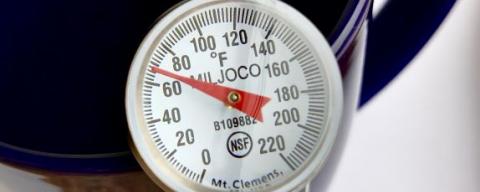Using a Bimetallic Stemmed Thermometer
A bimetallic stemmed thermometer is a tool that measures temperature using a metal coil in its stem, displaying the reading on a dial. It is commonly used in food safety to measure the internal temperature of food and beverages. These thermometers usually measure temperatures from 0º F to 220º F.
- Calibrate the thermometer
- Clean and sanitize the thermometer (special alcohol wipe or sanitizer dip may be used)
- Air dry the thermometer
- Insert into food 1/2 inch past the indicator notch
- Take the reading when dial stops moving
- Clean and re-sanitize the thermometer
Do not leave the thermometer in the food while it is cooking.
Calibrating a Bimetallic Stemmed Thermometer
Using a thermometer is the best method of determining if a food is adequately cooked. However, a thermometer is of no use if it is not measuring the temperature of food accurately. You should calibrate your thermometer any time it’s been dropped, if it does not appear to be taking accurate readings, and on a regular basis. The easiest way to calibrate a thermometer is by using the Ice Point Method.
Ice Point Method
- Fill a container with crushed ice and cold water. Let it set for about 1 minute.
- Place the thermometer’s stem or probe into the ice water to ½ inch past the indicator notch, making sure it doesn’t touch the sides or bottom of the container.
- Hold the thermometer for 30 seconds to 1 minute or until the reading stops. It should read 32°F.
- If the thermometer is a dial thermometer and doesn’t read 32°F, use a wrench to hold the calibration nut below the dial head and adjust the dial until the needle points to 32°F. Do this step while keeping the thermometer stem submerged in water.
- If you are checking a digital thermometer for accuracy, press the reset button and adjust it to read 32°F. Some digital thermometers cannot be recalibrated to read 32°F. You can calculate the difference each time you use it, but the best practice is to replace the thermometer.
You should check your thermometer’s package instructions for specific calibration steps. Thermometers should be calibrated regularly to ensure accurate temperature readings.


